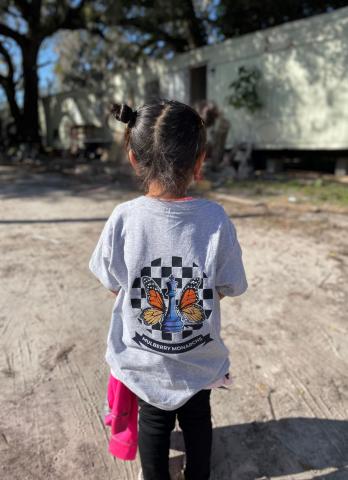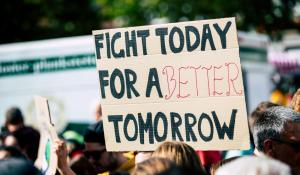
When Brenda Alvarez-Lagunas was nine years old, her mother’s job in the packaging department of a Florida factory came to an end. Brenda’s parents—Mexican immigrants looking for a way to support their young family—turned to farm work to make ends meet.
With the harvest coming at different times for different crops in different parts of the United States, the family’s farm work put them on the move, traveling north from Florida to North Carolina, and then back to Florida, following the seasons and the availability of the work. From the age of nine to 13, Brenda traveled with her family, joining her parents in the fields, helping to pick oranges, strawberries, blueberries, cucumbers, sweet potatoes, and other crops, along with her younger sisters.
When the family was outside of Florida, they often stayed in migrant farmworker camps attached to the fields. While this eased the complication of finding new housing at each new worksite, Brenda told Green America that conditions in the camps were harsh.

“My family of five was in one bedroom of a four-bedroom house where there was a family of four or five in each bedroom,” Brenda said. “I lived in other homes where the walls and floor didn’t connect, and you would have critters coming in, or wake up in the morning with flea bites all over your body.”
Brenda said that as a child, she didn’t fully comprehend that this way of life was a hardship, or that immigrant children, including unaccompanied minors, are prone to exploitation on US farms and other worksites.
US Child Labor: A Growing Problem
Brenda was just one of the estimated 500,000 children who work in agriculture in the US, according to the Association of Farmworker Opportunity Programs, as the prevalence of US child labor continues to rise—not just on farms but also in meatpacking, slaughterhouses, fast food, and other industries. Many child laborers are the children of immigrant parents, like Brenda, or unaccompanied migrant children.
In 2023, the US Department of Labor (DoL) investigated 955 illegal child labor cases nationwide, involving nearly 6,000 children. This represents an almost 50% increase in individual child-labor violations detected by the DoL over the previous year—and a whopping 472% increase over violations detected in 2015.
So far in 2024, the DoL has uncovered child-labor violations committed by a Pennsylvania Wendy’s franchise operating 21 restaurants, a Virginia Jersey Mike’s franchise operating four restaurants, a Tennessee Bojangles franchise, a Michigan Popeye’s franchise, two different Utah ice-cream parlors (a Cold Stone Creamery and a Baskin-Robbins franchise), a local Idaho restaurant, a New York water park, a Tennessee power equipment company and janitorial services company, an Ohio house-painting company, and an Alabama roofing company that illegally employed a 15-year-old who died after falling from a building during his first day on the job.
Despite the successful enforcement of these cases, they likely represent only a fraction of the children exploited by US employers, given that only cases detected by the government are counted. Other cases may remain hidden, and some forms of child work in the United States remain legal, outside of DoL oversight.
Green America’s Latest Work to Reduce US Child Labor
Green America has joined a coalition of trade unions, non-profit organizations, and academics, to form the Campaign to End US Child Labor, launched this past March. Together, the coalition is pushing back on child-labor rollbacks in several states, campaigning for greater protection of unaccompanied migrant children, calling for strong legislation to hold corporations accountable for child-labor law violations, and directly engaging some of the worst corporate offenders to urge them to improve their practices.
Green America also supports the bipartisan Preventing Child Labor Exploitation Act, federal legislation that would ensure that government contracts do not go to companies implicated in violating child labor laws. To urge your representatives to support this legislation, please use Green America’s online form:
US Law: Out of Step with International Standards
Nationwide, child labor in the United States is controlled by the Fair Labor Standards Act (FLSA) of 1938, which outlined the first standards restricting “oppressive child labor” in US workplaces. Individual states may choose to impose stronger standards than the FLSA, but as the Economic Policy Institute (EPI) has pointed out, no US state “currently complies with the minimum standards set forth…by the United Nations [UN] Convention on the Rights of the Child.”
This is largely due to agricultural exemptions in the FLSA that fall afoul of UN minimum working-ages provisions, allowing children like Brenda to work on US farms at younger ages, for longer hours, and in more hazardous conditions than in other industries. Child-labor opponents point out the racist origins of the exemptions in the FLSA, which were drafted at a time when Black Americans were overrepresented in agricultural labor, and now disproportionately affect Latin American asylum seekers.
Meanwhile, 176 other countries around the world follow stronger child-labor standards in agriculture, having ratified the international standards that the US has not.
Brenda urges Green Americans to support stronger legislation to protect child farmworkers. She specifically recommends an initiative championed for many years by Rep. Lucille Roybal-Allard (D, CA)—the first Mexican American in Congress—that would close child-labor loopholes in agriculture. Roybal-Allard retired in 2022, but her bill, the Children’s Act for Responsible Employment and Farm Safety (CARE) was reintroduced in 2023 by Rep. Raul Ruiz (D, CA). The Act would bring age and work-hour standards for children in agriculture up to the standards of other industries, provide children with greater protection against pesticides, and increase corporate penalties for employing children illegally.
States Pursuing Even Lower Standards
Beyond the US agriculture loophole, state legislators have proposed or passed laws weakening state-level restrictions on child labor in at least 21 states since 2022. In general, these efforts involve legalizing longer work hours for younger children, with less parental oversight, or in industries previously forbidden to minors. Most efforts have been led by Republican legislators and governors, though the New Jersey law expanding work hours for children was signed by its Democratic governor. At least seven states are considering changes in 2024.
For example, current bills in Indiana would remove hourly restrictions entirely from 16-and-17-year-olds and make it easier to employ children as young as 14 on farms during school hours. A current bill in Nebraska would lower the minimum wage for minors to $1.50 per hour less than the standard minimum wage for all workers. And bills in Kentucky would ban the state from enacting any laws stronger than federal standards and allow 12-and-13-year-old children to work in non-profit ventures, potentially leading to similar exemptions for other industries.
To check whether your state is involved in any child-labor rollbacks, and find sample letters to your representatives, check the legislative map maintained by the Campaign to End US Child Labor, of which Green America is a part.
Not every state that has considered weakening child labor laws has followed through. For example, Republican legislators withdrew a bill in Georgia that would have eliminated the need for work permits for children, and a bill in South Dakota that would have extended work hours for 14-year-olds until 9 pm. Your voice is important to show your state legislators that you care about protecting children.

Brenda Today & Her Advice for Voters
Brenda’s story doesn’t end with her farm work as a child. As she grew older, Brenda began to understand that not all children have to go to work, and she began to yearn to prioritize her schoolwork over her farm work. When she was in eighth grade, Brenda was pulling down straight As, and decided to talk to her mother about staying in Florida for the entire year to focus on her studies.
Brenda moved in with an aunt and uncle, completed high school, graduated as valedictorian, and earned a full scholarship to college. She graduated from Stanford University in 2023 and will soon be moving to take a job in New York City. For now, she is back in Florida, working for the RCMA Mulberry Community Academy, a dual-language charter school that provides an after-school program for the children of the migrant farmworker community.
“We understand the issues intimately and that makes us a very strong support system for our children,” says Brenda. Among other initiatives, Brenda started a chess club for the students, a soccer club, and scouting program. The overall program offers assistance to families in accessing essential services and provides children with a safe space while parents are working.
Still, she points out that without stronger legal protections for children, after-school services can only go so far. She urges voters to speak with candidates about child-labor issues across all industries, noting that she has spoken to politicians who were unaware of the scope of the problem, or the gaps in US labor law.
“Candidates need to be exposed to this issue,” Brenda says. Children are some of our most vulnerable population, that’s why we need to protect them.”
Questions to ask candidates:
- Do you support the right of states to enact child-labor protections stronger than those enshrined in federal law?
- Will you pledge to work against any loosening of child-labor laws under the purview of your office? (See uschildlabor.org for information on issues in specific states.)
- Do you support the Preventing Child Labor Exploitation Act, introduced by Sens. Cory Booker (D, NJ) and Josh Hawley (R, MO) to prevent federal government contracts with companies implicated in violating child labor law?
- Do you support the Children’s Act for Responsible Employment and Farm Safety (CARE), sponsored by Rep. Raul Ruiz (D, CA)?
- Do you support ratification of the UN Convention on the Rights of the Child, and bringing US agricultural labor laws in line with international standards on child rights?







